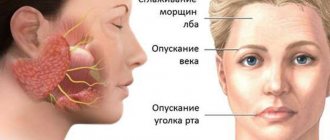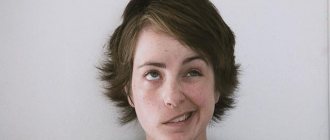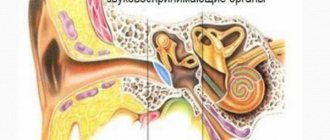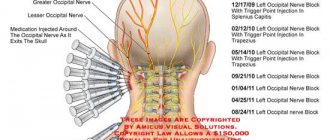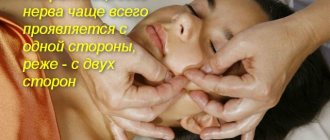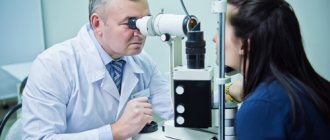A patient with neuritis of the facial nerve can be seen from afar: a distorted mouth, an eye, a crooked smile, and impaired facial expressions are immediately noticeable. But the worst thing is that the time for treatment of facial neuritis is limited. If the nerves are not restored within 3-6 months, then the chances of recovery begin to decrease sharply. In a year or two, it will only be possible to reduce the obvious manifestations, but not get rid of them completely. If 5-10 years have passed, then all efforts will already be aimed at at least partially “waking up” the nerve endings.
How does neuritis of the facial nerve appear?
Neuritis of the facial nerve can begin with mild pain in the ear area. Simultaneously with the onset of pain or after a couple of days, the facial muscles partially or completely lose mobility. The patient's face becomes distorted, the affected part freezes in the mask.
With timely treatment, the patient has a great chance of recovery - in 75% of cases the disease goes away completely. If facial paralysis does not resolve within three months, the patient's chances of making a full recovery are greatly reduced.
In order for facial neuritis to pass without consequences, you need to consult a doctor in the first hours after the onset of symptoms.
Clinical manifestations of neuralgia
The following symptoms are characteristic of trigeminal neuralgia:
- attacks of severe pain;
- increased pain during any actions with the mouth (chewing, opening, etc.);
- facial distortion;
- concentration of pain in the eyes, ears, teeth, mouth;
- teak.
Trigeminal facial neuralgia is characterized by attacks of stabbing, cutting, pulling pain lasting up to 1 minute. In the vast majority of cases, one side of the face is affected, but there are cases when pathological processes spread to the entire face. Painful sensations can be projected into the teeth and can cause the removal of a completely healthy tooth.
Symptoms
The following symptoms of inflammation of the facial nerve are distinguished:
- partial or complete impairment of facial muscle movements;
- the corner of the mouth lowers, the nasolabial fold on one side is smoothed out;
- the face becomes asymmetrical;
- the eyelid does not close completely;
- the eyeball protrudes and turns upward;
- pain in the ear, taste disorder;
- watery or dry eyes;
- hearing loss or sensitivity to loud sounds;
- the patient cannot whistle or stretch out his lips with a straw.
Trigeminal neuralgia as a complication of implantation
Unfortunately, one of the fairly common causes of damage to the facial (more precisely, trigeminal) nerve is dental implantation. According to recent studies, the frequency of such complications at this time does not exceed 2.95% (that is, it occurs in 5 out of 169 patients), and only 1.7% of patients are diagnosed with permanent neuropathy, requiring microsurgical correction of the situation1. If the implant is incorrectly selected in length, with increased pressure during its installation, there is a high risk of damage to one of the branches of the trigeminal nerve (passing on the lower or upper jaw). The result is pain or numbness in a certain area, long-term rehabilitation.
Injuries are caused by compression of a given nerve, its stretching, partial or complete damage. In the case of sprain or compression without compromising the integrity of the trigeminal nerve, the sensations pass quite quickly - within up to 7 days as blood circulation in the bone tissue improves. But if there was partial damage to the fibers of the nerve bundle, then the rehabilitation process can take from 14 days to 6 months. In cases of severe trauma, implants may need to be reinstalled because the body of the implant interferes with the restoration of axons (processes) in the nerve bundles.
In our clinic, before the operation, careful computer planning of the placement of implants is carried out, after which surgical templates are printed, protecting the patient and the doctor from incorrect installation of implants. Immediately, or the next day after the operation, a control computed tomography is performed, at which the control commission (consilium of doctors), in accordance with international quality assessment protocols, compares the placement of implants with the original plan and makes a conclusion about the success of the operation, or makes recommendations to the attending physician on the need to take additional measures.
Important! Do not confuse nerve damage with compression on it that occurs in the bone as a result of swelling after the installation of implants located close to the nerve endings. Compression goes away along with swelling and numbness in this situation is a normal reaction. Most often, such symptoms typically appear 2-3 days after multiple implantations; they are a normal reaction to tissue injury when screwing in implants and damage to intraosseous capillaries. Improvements will be noticeable almost immediately after installing the prosthesis on the implants and activating the chewing load, and with it the restoration and blood circulation in the bones.
Please note that there is no point in hiding the fact of damage to the trigeminal nerve for the doctor and the clinic; it will reveal itself anyway - this is the first thing. Secondly, even if this happened, the consequences are eliminated by properly selected therapy and joint work between the doctor and the patient. Yes, if damage occurs, then the patient will have to undergo quite a long period of rehabilitation (up to 6 months), but in difficult clinical situations of complete absence of teeth and low quality bone tissue, the doctor works in very limited conditions, so, unfortunately, some consequences but not life-threatening and health dysfunction cannot always be avoided.
Expert opinion
Nikolay Vladimirovich Namdakov Maxillofacial surgeon, implantologist, orthopedist Work experience 17+
“During one-stage implantation, we very often use elongated implant models that are installed in the deep parts of the bone tissue. Naturally, this increases the risk of damage to the nerves, which in this case are located very close to the implants. However, in our work we use three-dimensional visualization - we carefully study the implantation process in a computer program, where we set all the parameters of the jaw system of a particular patient. This allows us to eliminate the possibility of damage to the facial nerve during surgery, even in difficult clinical conditions of bone atrophy.”
Causes of inflammation
Primary neuritis of the facial nerve occurs due to:
- hypothermia of the face, cold, wind, drafts;
- insufficient blood supply (ischemia) to the nerve.
Secondary neuritis of the facial nerve is caused by the following reasons:
- inflammatory diseases of the ear: otitis media, eustachitis, mastoiditis;
- infections: mumps virus, measles, herpes;
- traumatic brain injuries;
- vascular disorders - for example, atherosclerosis of the vertebral arteries;
- brain tumors;
- anesthesia of the inferior alveolar nerve by the dentist.
Other factors that provoke inflammation include:
- traveling on a bus or minibus next to an open window;
- long work under air conditioning;
- metabolic disorders in the body;
- endocrine diseases - for example, diabetes;
- hypertension, intoxication of the body;
- nervous stress, emotional instability.
Treatment of neuralgia
Treatment of neuralgia is a long and difficult process, but doctors at the CELT Pain Clinic know how to carry it out with maximum positive effect. For this purpose it is used for the treatment method.
Conservative method
Conservative treatment involves taking medications:
- antispasmodics;
- anticonvulsants
Radiofrequency rhizotomy
- Cost: 35,000 rub.
- Duration: 15-30 minutes
- Hospitalization: 2 hours in hospital
More details
It is very important to correctly calculate the dosage of medications and take them regularly, since this is the only way to achieve the desired effect. It is equally important to regularly attend physiotherapeutic procedures:
- Bernard currents;
- acupuncture;
- paraffin applications.
If this treatment method does not bring the desired effect, the attending physician may decide on surgical treatment.
Complications of the disease
Neuritis of the facial nerve can lead to contracture of the facial muscles. It appears 4-6 weeks after the onset of the disease due to incomplete restoration of the motor functions of the facial muscles. Contracture is a contraction of the muscles of the affected half of the face. At the same time, it seems that it is not the diseased part of the face that is paralyzed, but the healthy one.
To avoid complications of inflammation of the facial nerve, you need to consult a doctor in time. For prevention, we recommend doing facial exercises. You will find examples of exercises at the end of the article.
Diagnosis of neuralgia
Diagnosis of neuralgia in the CELT Clinic does not cause difficulties, since it has a number of pronounced signs. When talking about the clinical manifestations of the disease, patients try not to touch the affected side of the face and remain in a tense state because they expect a new attack.
Studies are carried out on the functions of the facial and trigeminal nerves, which begin with assessing the symmetry of the patient’s face. In addition, a number of tests are carried out to check taste and sensitivity.
For the most accurate diagnosis of pathological processes in the nerves of the face, an ultrasound scan of the nerves is performed.
How to speed up recovery
In order for the restoration of damaged nerves to occur faster, it is advisable to supplement the treatment prescribed by the doctor with gymnastics. It allows you to use the areas of the face affected by the affected nerve. The set of exercises consists of puffing out the cheeks, moving the tongue to the sides, frowning the eyebrows and forehead, circular movements of the eyes, pulling in and out the lips, cheeks and many other movements.
At home, you can warm up by applying a thick fabric bag to the sore spot on the face, into which salt or sand heated in the microwave is poured. The duration of warming up should be no more than 30 minutes, the procedure is carried out before bedtime for a month. However, such procedures, like physical therapy, can be started no earlier than a week after the onset of inflammation.
It is advisable for patients with neuritis to avoid hypothermia and exposure to drafts, to protect themselves from viral diseases and stress, and also to ensure that their diet contains enough protein foods, vegetables and fruits.
Blepharospasm
The orbicularis oculi muscle surrounds the human eye socket on the face. Thanks to it, a person can close his eyelids and close his eyes. A condition in which involuntary contraction of this muscle occurs is called blepharospasm.
The main causes of blepharospasm:
- Facial paraspasm. This disease usually occurs in older people. It is believed to be caused by an imbalance between parts of the nervous system. Blepharospasm is one of the manifestations of facial paraspasm. The second possible manifestation is oromandibular dystonia - grimaces, trembling of the lower jaw, its involuntary movements. Sometimes blepharospasm is combined with oromandibular dystonia;
- Parkinson's disease;
- Multiple sclerosis;
- Meningitis, meningoencephalitis;
- Atherosclerosis of cerebral vessels, cerebrovascular accidents;
- Poisoning with toxic substances and certain medications;
- Inflammatory diseases of the eye (keratitis, conjunctivitis), nose, paranasal sinuses, teeth. As a result of the spread of the inflammatory process, the branches of the trigeminal nerve are irritated and reflex blepharospasm occurs.
Typically, a sick person begins to blink quickly, gradually the tension of the orbicularis muscle increases, and the eye narrows. At times, strong involuntary squinting occurs. Because of this, the eye cannot fully perform its functions and severe inconvenience occurs.
With such symptoms, you need to visit an ophthalmologist and neurologist. After the examination, the doctor may prescribe an electromyography or MRI of the head. It is important to identify the disease that led to the development of blepharospasm - this will help to correctly prescribe treatment.
Treatment
- Treatment of the underlying disease;
- Sedatives;
- Physiotherapy and reflexology.
- Drugs that improve cerebral blood flow and nervous system function;
- To reduce the tone of the orbicularis oculi muscle, a neurologist may prescribe botulinum therapy.
The greatest chances for a favorable outcome and complete restoration of impaired functions are in cases where proper treatment is started on time. If the first symptoms occur, do not delay visiting a doctor.
It is also worth remembering that sudden facial asymmetry is one of the symptoms of a stroke. This is a dangerous condition. It requires immediate hospitalization in a hospital.
